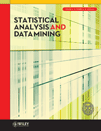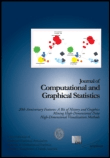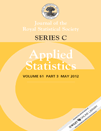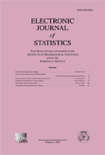
ENVIRONMENTAL AND ECOLOGICAL STATISTICS
Scope & Guideline
Exploring the synergy between ecology and quantitative analysis.
Introduction
Aims and Scopes
- Bayesian Statistical Methods:
The journal emphasizes the use of Bayesian methodologies for ecological and environmental data analysis, enhancing the understanding of uncertainty in ecological models. - Spatio-Temporal Modeling:
A significant focus is on spatio-temporal modeling techniques that address the dynamics of environmental processes over time and space, crucial for understanding phenomena like pollution and climate change. - Ecological Data Analysis:
The journal publishes research on various statistical techniques for analyzing ecological data, including occupancy models, species distribution modeling, and functional data analysis. - Machine Learning Applications:
It explores the integration of machine learning techniques within ecological and environmental statistics, particularly for predictive modeling and pattern recognition in complex datasets. - Environmental Monitoring and Assessment:
Research on statistical methods for monitoring and assessing environmental changes and impacts, including climate variability, pollution levels, and biodiversity metrics, is a core focus. - Multivariate and Copula Models:
The journal addresses the application of multivariate statistical methods and copula models to study dependencies between multiple environmental factors and ecological variables.
Trending and Emerging
- Machine Learning and AI Techniques:
There is a growing trend in the application of machine learning and artificial intelligence techniques in environmental statistics, particularly for predictive modeling and data-driven insights in ecological studies. - Climate Change Impact Assessment:
Research focusing on the statistical modeling of climate change impacts on various ecological systems is increasingly prominent, reflecting the urgent need to understand and mitigate climate-related challenges. - High-Dimensional and Complex Data Analysis:
The journal is increasingly publishing studies that deal with high-dimensional data and complex ecological systems, which require advanced statistical techniques for effective analysis. - Causal Inference in Environmental Studies:
Emerging interest in causal inference methods is evident, particularly in understanding the direct impacts of environmental policies and changes on ecological outcomes. - Integrative Approaches to Data Fusion:
There is a trend towards integrating multiple data sources and types (e.g., satellite imagery, ground-based observations) to provide comprehensive ecological insights, indicating a move towards more holistic research methodologies.
Declining or Waning
- Traditional Regression Models:
There seems to be a waning interest in traditional regression models without incorporating advanced techniques. The focus has shifted towards more complex models that account for spatial and temporal dependencies. - Basic Descriptive Statistics:
There is a noticeable decline in papers focusing solely on basic descriptive statistics. The journal is evolving towards more sophisticated analyses that provide deeper insights into ecological data. - Generalized Linear Models (GLMs):
While GLMs were once a dominant method in ecological statistics, their prevalence appears to be decreasing as more advanced and flexible modeling approaches gain traction.
Similar Journals

Austrian Journal of Statistics
Innovative Insights in Statistics and Applied MathematicsAustrian Journal of Statistics, published by the AUSTRIAN STATISTICAL SOC, serves as a prominent platform for disseminating innovative research in the fields of statistics and applied mathematics. Established as an open-access journal in 1996, it aims to promote the exchange of knowledge and advancements among researchers, academics, and practitioners, particularly in Austria and beyond. With an ISSN of 1026-597X, this journal has gained recognition despite its current standing in the lower quartiles in various Scopus rankings. It covers a wide breadth of topics including statistics, probability, and uncertainty, appealing to a diverse audience of researchers aiming to enhance their understanding of these critical disciplines. By offering unrestricted access to its content, the Austrian Journal of Statistics provides invaluable resources for both emerging and established voices in the field, making it a vital source for academics and professionals alike. Research published here contributes to the ongoing dialogue surrounding statistical methodologies and applications, making it indispensable for anyone engaged in data analysis and interpretation.

Statistical Analysis and Data Mining
Advancing Knowledge with Data-Driven DiscoveriesStatistical Analysis and Data Mining is a leading journal published by WILEY, dedicated to exploring the latest advancements in statistical methods and data mining techniques. With an ISSN of 1932-1864 and an E-ISSN of 1932-1872, this journal serves as a significant platform for researchers and professionals in statistical analysis, computer science applications, and information systems. Covering a wide range of topics from innovative analytical methodologies to emerging data mining algorithms, the journal aims to disseminate high-quality research that contributes to the evolving landscape of data science. Ranked in the Q2 category for the fields of Analysis, Computer Science Applications, and Information Systems in 2023, it emphasizes its relevance and impact within academia. While it offers limited Open Access options, the insights shared in this publication are integral for those wishing to stay ahead in fast-paced research and data-driven industries. Since its inception in 2008 and continuing through 2024, Statistical Analysis and Data Mining invites submissions that reflect rigorous empirical research coupled with practical implications, making it a vital resource for the academic community.

Chilean Journal of Statistics
Exploring the frontiers of statistical methodologies.The Chilean Journal of Statistics is a vital resource for researchers, professionals, and students dedicated to the field of statistics and probability. Published by SOC CHILENA ESTADISTICA-SOCHE, this journal serves as a platform for the dissemination of innovative research and advancements in statistical methodologies, data analysis, and applications. With an ISSN of 0718-7912 and E-ISSN 0718-7920, the journal features contributions from the statistical community in Chile and beyond, reflecting its growing influence as evidenced by its classification in the Q3 quartile for 2023. Operating out of Chile, specifically from Santiago, the journal aims to converge its scope from 2019 to 2024 on providing high-quality, peer-reviewed articles that can inform and inspire academic and professional practices. While it is not an open-access journal, it remains a crucial outlet for impactful statistical research, fostering a deeper understanding of statistical concepts and their real-world applications.

JOURNAL OF COMPUTATIONAL AND GRAPHICAL STATISTICS
Connecting researchers to the latest in statistical innovation.JOURNAL OF COMPUTATIONAL AND GRAPHICAL STATISTICS is a premier academic publication dedicated to advancing the fields of computational statistics and graphical data representation. Published by Taylor & Francis Inc, this journal stands out with its impressive Q1 rankings in Discrete Mathematics and Combinatorics, Statistics and Probability, and Statistics, Probability and Uncertainty, reflecting its high impact and relevance in contemporary research. Since its inception in 1992, the journal has been a vital resource for researchers, professionals, and students alike, with its rigorous peer-reviewed articles contributing significantly to the science of data analysis and visualization. With a Scopus ranking placing it within the top tiers of its category, the journal is committed to disseminating high-quality research that promotes innovation and methodological advancement. Note that the journal currently follows a traditional subscription model, ensuring focused and curated content for its readers. As it approaches the horizon of 2024, the JOURNAL OF COMPUTATIONAL AND GRAPHICAL STATISTICS continues to foster scholarly discourse and discoveries, making it an essential platform for anyone involved in statistics and data science.

STATISTICAL PAPERS
Advancing the Frontiers of Statistical KnowledgeSTATISTICAL PAPERS, published by Springer, is a leading journal in the field of Statistics and Probability that has been contributing to the academic community since 1988. With an impressive track record spanning over three decades, this journal falls within the prestigious Q2 quartile in both the Statistics and Probability and Statistics, Probability and Uncertainty categories, signifying its high-quality research output. It currently ranks #92 out of 278 in the Mathematics - Statistics and Probability category and #61 out of 168 in Decision Sciences - Statistics, Probability and Uncertainty, placing it in the 67th and 63rd percentiles respectively. Although the journal is not open access, it offers a vital platform for researchers, professionals, and students seeking to disseminate their findings and stay abreast of the latest advancements in statistical methods and applications. With its commitment to the highest standards of scholarship, STATISTICAL PAPERS plays a crucial role in shaping contemporary statistical discourse and fostering innovation within the field.

International Journal of Ecological Economics & Statistics
Exploring the Intersection of Environment and Economic Analysis.The International Journal of Ecological Economics & Statistics is a critical platform for research in the intersecting fields of ecological economics and statistical analysis. Published by the CENTRE ENVIRONMENT SOCIAL & ECONOMIC RESEARCH (PUBL-CESER), this journal aims to promote scholarly discussion and knowledge dissemination regarding sustainable economic practices and quantitative research methodologies. Despite the discontinuation of its coverage in Scopus, the journal continues to play a significant role in enhancing the understanding of the economic aspects of environmental issues within a global context. Researchers and professionals engaged in the fields of economics, decision sciences, and environmental studies are particularly invited to contribute and stay updated with the latest findings and theories. With its commitment to fostering academic discourse, the journal aspires to bridge the gap between environmental sustainability and economic growth, equipping readers with essential insights for future applications.

Korean Journal of Applied Statistics
Innovating Statistical Practices Across DisciplinesKorean Journal of Applied Statistics, published by the Korean Statistical Society, is a prominent journal dedicated to advancing the field of applied statistics. ISSN 1225-066X (Print) and E-ISSN 2383-5818 (Online), this journal serves as a vital platform for disseminating high-quality research that addresses the latest methodologies, applications, and innovations in statistical practices. Though currently not an open-access journal, it aims to foster collaboration among statisticians, researchers, and practitioners by providing rigorous peer-reviewed articles that enhance understanding and application of statistical techniques across various disciplines. With a commitment to integrating theory and practice, the Korean Journal of Applied Statistics stands as a crucial resource for those seeking to influence the evolving landscape of statistical research and its applications in Korea and beyond.

JOURNAL OF THE ROYAL STATISTICAL SOCIETY SERIES C-APPLIED STATISTICS
Connecting Research and Practice in Applied StatisticsThe JOURNAL OF THE ROYAL STATISTICAL SOCIETY SERIES C - APPLIED STATISTICS, published by the Oxford University Press, serves as a critical platform for disseminating innovative research within the field of applied statistics. With its ISSN 0035-9254 and E-ISSN 1467-9876, this journal provides a comprehensive resource for statisticians and practitioners alike, focusing on the development and application of statistical methodologies to real-world problems. As of 2023, it is ranked in the Q2 quartile within both the Statistics and Probability categories, reflecting its significant contribution to the discipline as evidenced by its Scopus ranking. Although it does not offer open access, the journal maintains a rigorous peer-review process and publishes issues regularly, with coverage extending from 1981 to 2024. By focusing on practical applications of statistical methods, the journal aims to bridge the gap between theory and application, making it an essential read for researchers, professionals, and students who are keen on advancing their understanding of statistics in various domains.

Electronic Journal of Statistics
Transforming Data into KnowledgeElectronic Journal of Statistics, published by INST MATHEMATICAL STATISTICS-IMS, is a premier open-access platform dedicated to the field of statistics and probability, with a remarkable track record since its inception in 2007. With an ISSN of 1935-7524, this journal has quickly established itself as a leading resource within the top Q1 category in both Statistics and Probability, as well as Statistics, Probability and Uncertainty, highlighting its significance and impact in the academic community. The journal’s commitment to disseminating high-quality research allows researchers, professionals, and students to access valuable findings and methodologies that contribute to the advancement of statistical sciences. With its convergence set to continue until 2024, the Electronic Journal of Statistics remains a vital source for scholars looking to enrich their knowledge and engage with cutting-edge statistical theories and applications.

Statistics in Biosciences
Fostering Collaboration in Statistical Bioscience ResearchStatistics in Biosciences is a distinguished journal published by Springer, focusing on the innovative interplay between statistical methodologies and biosciences. Established in 2009, this journal aims to provide a platform for the dissemination of cutting-edge research in statistical applications within biochemistry, genetics, and molecular biology. With an impressive impact factor and a distinguished ranking in multiple categories, including Q2 in Biochemistry, Genetics and Molecular Biology (miscellaneous) and Q3 in Statistics and Probability, it serves as a crucial resource for researchers, professionals, and students seeking to deepen their understanding of statistical applications in biological contexts. The journal is accessible through traditional subscription models, ensuring that high-quality research remains available to a wide audience. Featuring contributions that advance statistical theory and application in the biosciences, Statistics in Biosciences is committed to fostering collaboration and innovation in a rapidly evolving scientific landscape.